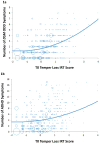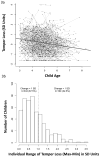Clinical Implications of a Dimensional Approach: The Normal:Abnormal Spectrum of Early Irritability
- PMID: 26210331
- PMCID: PMC4515952
- DOI: 10.1016/j.jaac.2015.05.016
Clinical Implications of a Dimensional Approach: The Normal:Abnormal Spectrum of Early Irritability
Abstract
Objective: The importance of dimensional approaches is widely recognized, but an empirical base for clinical application is lacking. This is particularly true for irritability, a dimensional phenotype that cuts across many areas of psychopathology and manifests early in life. We examine longitudinal, dimensional patterns of irritability and their clinical import in early childhood.
Method: Irritability was assessed longitudinally over an average of 16 months in a clinically enriched, diverse community sample of preschoolers (N = 497; mean = 4.2 years; SD = 0.8). Using the Temper Loss scale of the Multidimensional Assessment Profile of Disruptive Behavior (MAP-DB) as a developmentally sensitive indicator of early childhood irritability, we examined its convergent/divergent, clinical, and incremental predictive validity, and modeled its linear and nonlinear associations with clinical risk.
Results: The Temper Loss scale demonstrated convergent and divergent validity to child and maternal factors. In multivariate analyses, Temper Loss predicted mood (separation anxiety disorder [SAD], generalized anxiety disorder [GAD], and depression/dysthymia), disruptive (oppositional defiant disorder [ODD], attention-deficit/hyperactivity disorder [ADHD], and conduct disorder [CD]) symptoms. Preschoolers with even mildly elevated Temper Loss scale scores showed substantially increased risk of symptoms and disorders. For ODD, GAD, SAD, and depression, increases in Temper Loss scale scores at the higher end of the dimension had a greater impact on symptoms relative to increases at the lower end. Temper Loss scale scores also showed incremental validity over DSM-IV disorders in predicting subsequent impairment. Finally, accounting for the substantial heterogeneity in longitudinal patterns of Temper Loss significantly improved prediction of mood and disruptive symptoms.
Conclusion: Dimensional, longitudinal characterization of irritability informs clinical prediction. A vital next step will be empirically generating parameters for the incorporation of dimensional information into clinical decision-making with reasonable certainty.
Keywords: developmental psychopathology; dimensional; irritability; longitudinal modeling; normal:abnormal spectrum.
Copyright © 2015 American Academy of Child and Adolescent Psychiatry. All rights reserved.
Conflict of interest statement
Disclosure: Drs. Wakschlag, Estabrook, Petitclerc, Henry, Perlman, Voss, Pine, Leibenluft, Briggs-Gowan, and Mr. Burns report no biomedical financial interests or potential conflicts of interest.
Figures



References
-
- Stringaris A, Goodman R. Longitudinal outcome of youth oppositionality: Irritable, headstrong, and hurtful behaviors have distinctive predictions. J Am Acad Child Adolesc Psychiatry. 2009;48:404–412. - PubMed
-
- Deater-Deckard K, Wang Z. Anger and irritability. In: Zentner M, Shiner RL, editors. Handbook of Temperament. New York: Guilford Press; 2012. pp. 124–144.
Publication types
MeSH terms
Grants and funding
LinkOut - more resources
Full Text Sources
Other Literature Sources
Medical
Miscellaneous

